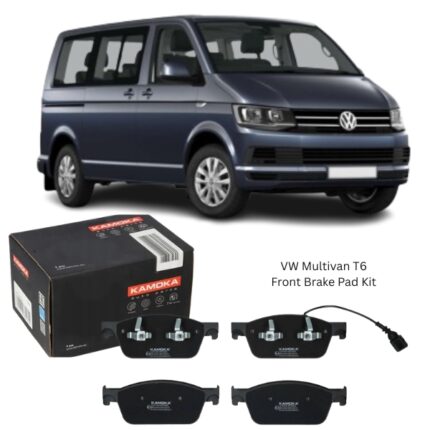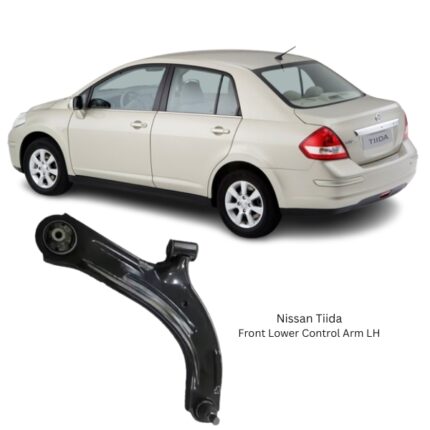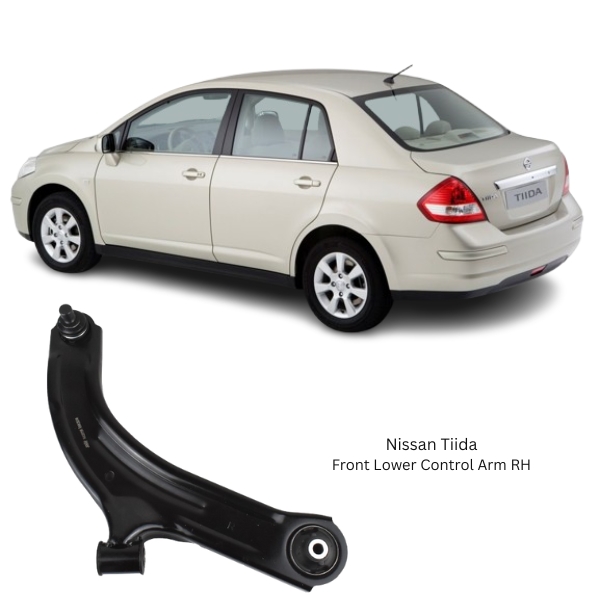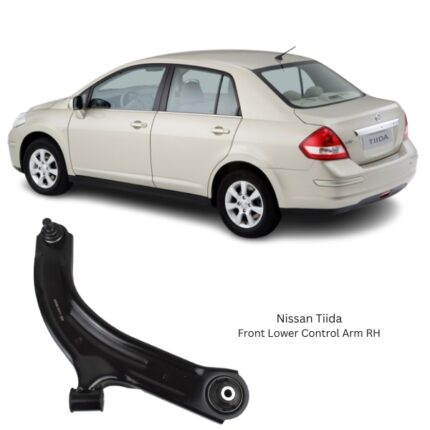Get Nissan Tiida Front Lower Control Arm RH 54500-ED000 in Kenya
The front lower control arm (RH) is a fundamental component in the vehicle’s front suspension system. Serving as a key structural link between the chassis and the wheel assembly, the lower control arm plays a critical role in steering stability, ride comfort, and overall vehicle control. Positioned on the right-hand (passenger) side of the vehicle, this component works in coordination with the suspension strut, steering knuckle, and other components to ensure proper wheel alignment and smooth suspension articulation.
A well-functioning control arm contributes significantly to safe driving dynamics, especially when the vehicle encounters bumps, potholes, and uneven terrain. When compromised due to wear, impact damage, or corrosion, the integrity of the entire front suspension can be jeopardized, leading to degraded handling, excessive tire wear, and potentially unsafe driving conditions.
Function and Purpose
The primary function of the front lower control arm RH is to connect the wheel hub and steering knuckle to the vehicle’s frame or subframe. It acts as a pivot point, allowing the wheels to move up and down in response to road conditions while keeping the wheels aligned with the vehicle body.
This component is responsible for:
-
Maintaining wheel alignment angles (especially camber and caster).
-
Supporting vertical loads transmitted from the road surface.
-
Managing longitudinal and lateral forces during acceleration, braking, and turning.
-
Allowing suspension travel while keeping the wheel assembly correctly positioned.
The control arm permits smooth, controlled motion of the suspension system while ensuring that the tire contact patch remains stable, maximizing grip, safety, and ride quality.
Construction and Design
The front lower control arm RH is typically constructed from stamped steel, forged aluminum, or cast iron, depending on the vehicle’s suspension design and performance requirements. These materials offer an ideal balance of strength, rigidity, and weight savings.
Key structural elements include:
-
Control Arm Body: The main arm-shaped frame, usually in a wishbone or A-arm shape, engineered to withstand high loads while minimizing flex.
-
Ball Joint Housing: Located at the outer end of the arm, this connects to the steering knuckle and allows for multi-directional movement. Some designs have the ball joint permanently integrated, while others feature bolt-on or press-fit joints.
-
Bushing Mounts: The inboard (chassis-side) ends are fitted with rubber or hydraulic bushings to absorb road vibrations and allow controlled pivoting. These bushings isolate the chassis from road harshness while maintaining suspension geometry.
-
Mounting Points: These are reinforced regions where the control arm bolts to the subframe or cross member, designed for precise alignment and long-term durability.
Ball Joint and Bushings
Two critical subcomponents of the control arm are the ball joint and bushings.
-
Ball Joint:
-
Acts as a flexible connection point between the control arm and the steering knuckle.
-
Allows for steering movement and vertical suspension travel simultaneously.
-
Must be strong and wear-resistant due to constant load-bearing and rotational movement.
-
If worn or loose, it can cause steering play, knocking noises, and unstable handling.
-
-
Bushings:
-
Typically made of rubber, polyurethane, or synthetic elastomers.
-
Serve to dampen vibrations and absorb shock from road surfaces.
-
Allow the control arm to pivot smoothly during suspension movement.
-
Worn bushings can lead to clunking noises, vibration, and poor wheel alignment.
-
Both the ball joint and bushings are considered wear items and are critical to the control arm’s overall functionality. Depending on the design, they may be serviceable or integrated.
Importance of the Right-Hand Side (RH) Control Arm
While the left and right control arms may appear symmetrical, they are often side-specific due to their unique mounting angles and orientation relative to other suspension components. The RH (right-hand) control arm is specifically designed for the passenger side and should never be interchanged with the LH (left-hand) arm.
Side-specific considerations include:
-
The direction of bushing and ball joint tapering.
-
Mounting bracket orientations.
-
Clearance with other components such as the engine mount, exhaust, or sway bar.
-
Geometry alignment with steering linkage and strut assembly.
Using the correct side-specific part ensures proper suspension geometry and safe operation.
Common Signs of a Failing Front Lower Control Arm
Like all suspension parts, the front lower control arm RH is subjected to stress and wear over time. Signs of wear or damage include:
-
Unusual Noises: Clunking, rattling, or popping sounds, especially when going over bumps or during turns.
-
Poor Handling: Loose steering feel, vehicle wandering, or increased body roll during cornering.
-
Excessive Tire Wear: Uneven or rapid wear patterns, especially on the inner or outer edges of the front tires.
-
Vibration: Noticeable shaking through the steering wheel, particularly at certain speeds or road conditions.
-
Misalignment: The vehicle pulling to one side or the steering wheel not centering correctly.
-
Visible Damage: Bent or cracked control arm body, torn bushings, or excessive ball joint play during visual inspection.
These symptoms should be addressed promptly, as continued driving with a damaged control arm can lead to compromised vehicle control or even component failure.
Installation and Replacement Considerations
Replacing a front lower control arm RH requires moderate mechanical skill and is typically performed with the vehicle lifted and the wheel removed. Key steps include:
-
Secure the Vehicle: Use a flat surface, jack stands, and wheel chocks.
-
Remove Wheel Assembly: To access the suspension components.
-
Disconnect Ball Joint: Usually via a cotter pin and castle nut, using a ball joint separator.
-
Unbolt the Arm from the Chassis: Carefully remove the mounting bolts and any sway bar or strut linkages.
-
Install the New Arm: Position it correctly, torque all bolts to specification, and ensure the ball joint is seated properly.
-
Reassemble and Align: Reattach the wheel, lower the vehicle, and perform a wheel alignment to restore factory suspension geometry.
Proper torque specifications, alignment checks, and test drives are essential to ensure the new component functions correctly.
Maintenance Tips
-
Regular Inspection: Periodically check for bushing wear, ball joint movement, and structural integrity during routine service.
-
Clean Surrounding Components: To avoid accelerated wear due to contamination or rust.
-
Check Alignment Annually: Or after significant pothole impacts or suspension service.
-
Replace in Pairs When Possible: Especially on older vehicles, to maintain symmetrical performance and lifespan.
Follow us on Facebook for more parts.





Reviews
Clear filtersThere are no reviews yet.